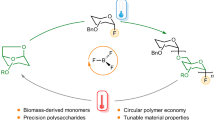Abstract
Low molecular weight xylan was modified at the reducing end with mono and bifunctional amines. Characterization by means of elemental analysis, nmr spectroscopy and mass spectrometry proved the success of the highly selective reaction. Modified xylan containing amino groups at the reducing end are capable to react with unmodified xylan and cellodextrins. The structure of the products obtained was proved by NMR spectroscopy. Size exclusion chromatography and mass spectrometry verified the increased molar mass of the head-head linked polysaccharides.










Similar content being viewed by others
References
Asker MMS, Manal GM, Ghada SI (2007) Structural characterization and biological activity of acidic polysaccharide fractions isolated from Bacillus polymyxa NRC-A. J Appl Sci Res 3:1170–1177
Borch RF, Bernstein MD, Durst HD (1971) Cyanohydridoborate anion as a selective reducing agent. J Am Chem Soc 93:2897
Daus S, Heinze T (2010) Xylan-based nanoparticles: prodrugs for ibuprofen release. Macromol Biosci 10:211–220. doi:10.1002/mabi.200900201
Ebringerova A (2005) Structural diversity and application potential of hemicelluloses. Macromol Symp 232:1–12. doi:10.1002/masy.200551401
Ebringerova A, Heinze T (2000) Xylan and xylan derivatives—biopolymers with valuable properties, 1. naturally occurring xylans structures, isolation procedures and properties. Macromol Rapid Commun 21:542–556. doi:10.1002/1521-3927(20000601)21:9<542::AID-MARC542>3.0.CO;2-7
Ebringerova A, Hromadkova Z, Heinze T (2005) Hemicellulose. Polysaccharides I, pp 1–67. doi:10.1007/b136812
Fredon E, Granet R, Zerrouki R, Krausz P, Saulnier L, Thibault JF, Rosier J, Petit C (2002) Hydrophobic films from maize bran hemicelluloses. Carbohydr Polym 49(1):1–12
Halkes KM, de Souza AC, Maljaars CEP, Gerwig GJ, Kamerling JP (2005) A facile method for the preparation of gold glyconanoparticles from free oligosaccharides and their applicability in carbohydrate-protein interaction studies. Eur J Org Chem 17:3650–3659. doi:10.1002/ejoc.200500256
Hasegawa T, Fujisawa T, Numata M, Matsumoto T, Umeda M, Karinaga R, Mizu M, Koumoto K, Kimura T, Okumura S, Sakurai K, Shinkai S (2004) Schizophyllans carrying oligosaccharide appendages as potential candidates for cell-targeted antisense carrier. Org Biomol Chem 2:3091–3098. doi:10.1039/B412124B
Jerez JR, Matsuhiro B, Urzua CC (1997) Chemical modifications of the xylan from palmaria decipiens. Carbohydr Polym 32:155–159
Kamitakahara H, Nakatsubo F (2010) Aba- and bab-triblock cooligomers of tri-o-methylated and unmodified cello-oligosaccharides: syntheses and structure-solubility relationship. Cellulose 17:173–186. doi:/10.1007/s10570-009-9348-3
Kardosova A, Matulova M, Malovíkova A (1998) (4-O-Methyl-[α]–glucurono)–xylan from Rudbeckia Fulgida, var. sullivantii (Boynton et Beadle). Carbohydr Res 308(1–2):99–105. doi:10.1016/S0008-6215(98)00072-X
Kasuya N, Kusaka Y, Habu N, Ohnishi A (2002) Development of chiral stationary phases consisting of low-molecular-weight cellulose derivatives covalently bonded to silica gel. Cellulose 9:263–269. doi:10.1023/A:1021188610098
Kobayashi S, Ohmae M (2006) Enzymatic polymerization to polysaccharides. Enzyme-catalyzed synthesis of polymers, pp 159–210
Liebert T, Seifert M, Heinze T (2008) Efficient method for the preparation of pure, water-soluble cellodextrines. Macromol Symp 262:140–149. doi:10.1002/masy.200850214
Petzold K, Schwikal K, Günther W, Heinze T (2005) Carboxymethyl xylan—control of properties by synthesis. Macromol Symp 232:27–36. doi:10.1002/masy.200551404
Rustighi I, Campa C, Rossi M, Semeraro S, Vetere A, Gamini A (2009) Analysis of n-acetylaminosugars by ce: a comparative derivatization study. Electrophoresis 30:2632–2639. doi:10.1002/elps.200800791
Schmid G, Biselli M, Wandrey C (1988) Preparation of cellodextrins and isolation of oligomeric side components and their characterization. Anal Biochem 175:573–583. doi:10.1016/0003-2697(88)90586-6
Stephen AM (1983) Other plant polysaccharides, polysaccharides, vol 2. Academic Press, New York, pp 97–193
Teleman A, Lundqvist J, Tjerneld F, Stålbrand H, Dahlman O (2000) Characterization of acetylated 4-O-methylglucuronoxylan isolated from aspen employing 1H and 13C nmr spectroscopy. Carbohydr Res 329(4):807–815. doi:10.1016/S0008-6215(00)00249-4
Zhang M, Zhang L, Cheung PCK, Ooi VEC (2004) Molecular weight and anti-tumor activity of the water-soluble polysaccharides isolated by hot water and ultrasonic treatment from the sclerotia and mycelia of pleurotus tuber-regium. Carbohydr Polym 56(2):123–128. doi:10.1016/j.carbpol.2004.01.005
Acknowledgments
The authors gratefully acknowledge Anja Baumgärtel from the work group of Prof. US Schubert for her efforts to acquire MALDI TOF mass spectra, Marcel Meiland for the preparation of cellodextrins and the Bene Pharmachem (Geretsried) for the generous financial support.
Author information
Authors and Affiliations
Corresponding author
Rights and permissions
About this article
Cite this article
Daus, S., Elschner, T. & Heinze, T. Towards unnatural xylan based polysaccharides: reductive amination as a tool to access highly engineered carbohydrates. Cellulose 17, 825–833 (2010). https://doi.org/10.1007/s10570-010-9421-y
Received:
Accepted:
Published:
Issue Date:
DOI: https://doi.org/10.1007/s10570-010-9421-y




